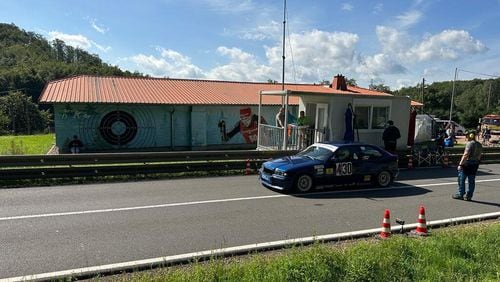The race enthusiast in me jumps at any chance to connect motorsports to Atlanta traffic. My recent trip to Germany with my wife, Momo, to see her — our — family gleaned my chance to attend my first race outside of the United States.
The Glasbach Berg-Slalom, a single-car, hill-climb time trial, is held just outside Momo’s home village of Barchfeld, in central Germany. And while the vast majority of auto races are held inside closed courses, this once-or-twice-annual event commences on the sinuous, narrow Glasbachstrasse that local drivers use every day.
Forested hills and cliffs, along with shoulder-snug guardrails, flank the two-lane mountain road. Like local roads here in the States, passing is not allowed in blind curves, which comprise many parts of the 5.5 km. (3.4 mi.) inclined race course.
Forgive the metric-usage; 10 days in Europe messes with one’s measure meter.
Momo, her stepfather Andreas, and I attended the race on my last full day in Deutschland. But I had been a passenger numerous times on Glasbach, named after the “Glass Creek” mountain on which the road wraps. I remember first learning of this race after commenting how this route would make for a fun race. Turns out that I wasn’t the first with this thought, as versions of this Glasbach race date back to the mid-20th century.
Our trip to Germany only coincidentally overlapped with this event, and I was happy to learn that Momo’s uncle Frank had secured tickets. This particular Glasbachrennen (Glasbach race) was not FIA-sanctioned (the world governing body that oversees Formula 1 and many other series). Some Glasbach races are, and they draw thousands of spectators.
This mountain climb was for hobby or semi-pro racers from all over Germany, many of whom race only a few times a year. And while there are various regional championships, the main objective for these racers is to best their own personal times — and to beat each other.
This race is similar to qualifying or time trials in other racing disciplines: one car at a time.
And these street-ready cars have very specific rules regarding what drivers and mechanics can add for performance and what is required for safety.
“(My) BMW 316 compact is in a standard class; not much can be changed,” driver Michelle Tute told the AJC and 95.5 WSB via Momo’s translation. “There is a standard engine, sports-drive suspension, and racing tires,” Tute explained, adding that much of the rest of the car, including the interior, is very similar to how the car came from the showroom.
Tute, like many of the 91 other drivers in the field, shares her blue BMW 316i Compact. Her father, Manfred “Opa Manni” Blasius, Driver No. 4, makes his uphill run and then is escorted with his group downhill and at slow speed. Tute drives up the hill as Driver No. 30. Same car.
Tute’s husband, Tony, is a decorated sports car driver in his own right, but helps watch their infant and is alongside the other spectators on this day.
These racers of various expertise began this cool morning in the Thuringian forest on wet pavement. Drivers tiptoed at speeds that we mortals still would not attempt in our grocery wagons, hoping not to disturb even one slalom-cone, much less tag the barriers.
But as the sun woke late on a Saturday morning, the course dried and added speed and the allure of finding it to each competitor’s subsequent attempt.
Hobby racer, test driver, and auto engineer Gerold Schneider traveled about 100 miles to campaign his red 1976 Opel (GM brand) Kadett C. Schneider traveled much farther to work as a test driver for Continental in Michigan, living in the U.S. from 2011 to 2014. He also campaigned a Chevy Camaro in select SCCA races in the Great Lakes State, becoming the only European champion in that division, he proudly told me.
But what of the challenges on this Glassbach route? Of the sharp curves, the heavy braking zones, the new slaloms — zigzags between orange cones — or constant shifting? What factor is most taxing for a racer?
“All of it, really,” Schneider very plainly said, after stepping from his travel van, which he used to transport and then tune on his red Opel. He races an Opel because its replacement parts are plentiful, he said. Of course, there was a practical reason for racing a car from five decades ago. We talked about racing (see the full interview on my “Five to Go Podcast” Facebook page), as we stood amongst a couple of dozen VWs, BMWs, Mazdas, and even a Ford or two.
And while Schneider says racing, “is just a hobby on the side,” that in no way means he does not pay acute attention to both his mechanical and race craft.
A German and his car.
This also holds true outside of the paddock. German people have special connections to their automobiles, and that bond brings the tale of this race very practically to every day commuting here in Georgia.
The average driving-IQ in Germany simply seems higher than it does back home. Drivers are forced to negotiate narrower lanes, in smaller cars, many with stickshifts, with greater fuel economy, at higher fuel costs, through more automated speed traps, in worse weather, and with stricter regulations on both car maintenance and behaviors-while-stranded than we do and have. These factors have, by my observations in four trips to Deutschland, begotten less recklessness and less distracted driving.
Consider, too, that sections of the German autobahn, the country’s interstate system, have unlimited speed limits. They treat this freedom with respect.
Traversing the Glasbach in daily life is a task. A tractor trailer may turn downhill as a compact VW curves up. The area might just be too narrow for both to pass at once. No worries. The driver of the smaller vehicle simply belches the throttle long enough for the gargantuan to brush past and within inches.
Maybe I was a passenger in a VW when this happened.
I did not notice one Glasbach passenger car weaving, as droves often see (and do) on commodious Atlanta roads. Rules don’t stymie distractions on the Glassbach, necessity does. The margin for error is nil. The guardrails nearly ride shotgun with each driver. One false twitch and a vehicle either scrapes the barrier or hits an oncomer head-on.
None of this is to say that the worst German commuter is better than the greatest American racer. Not at all. But many factors have generationally seemed to make German drivers and laws more conscientious of the consequences of driving mistakes. That axiom was on full display on a curving mountain route near Bad Liebenstein and Steinbach, where both everyday drivers and hobby racers challenge the turns and treat danger in automobiles with the respect it deserves.
Doug Turnbull, the PM drive Skycopter anchor for Triple Team Traffic on 95.5 WSB, is the Gridlock Guy. Download the Triple Team Traffic Alerts App to hear reports from the WSB Traffic Team automatically when you drive near trouble spots. Contact him at [email protected].







